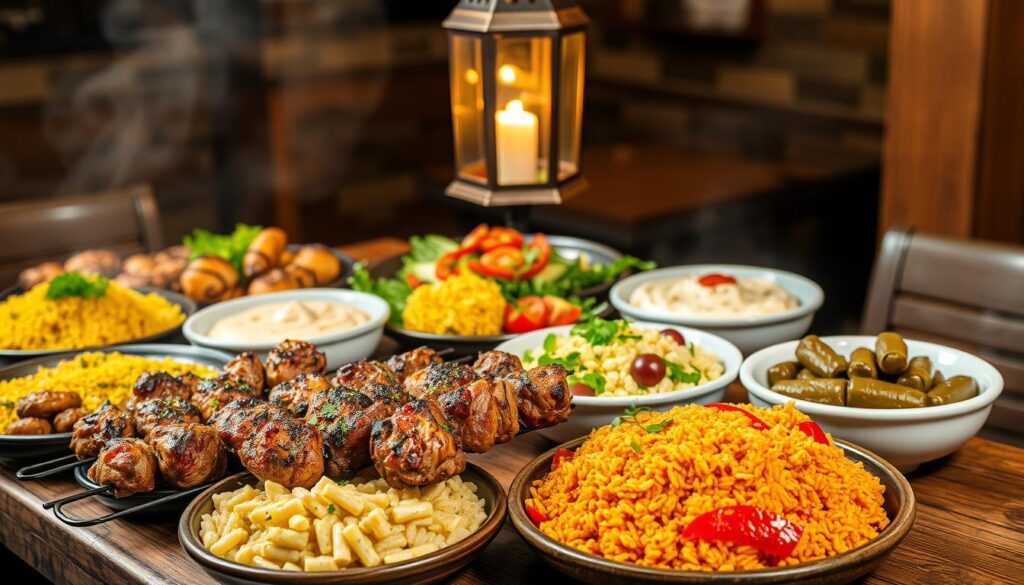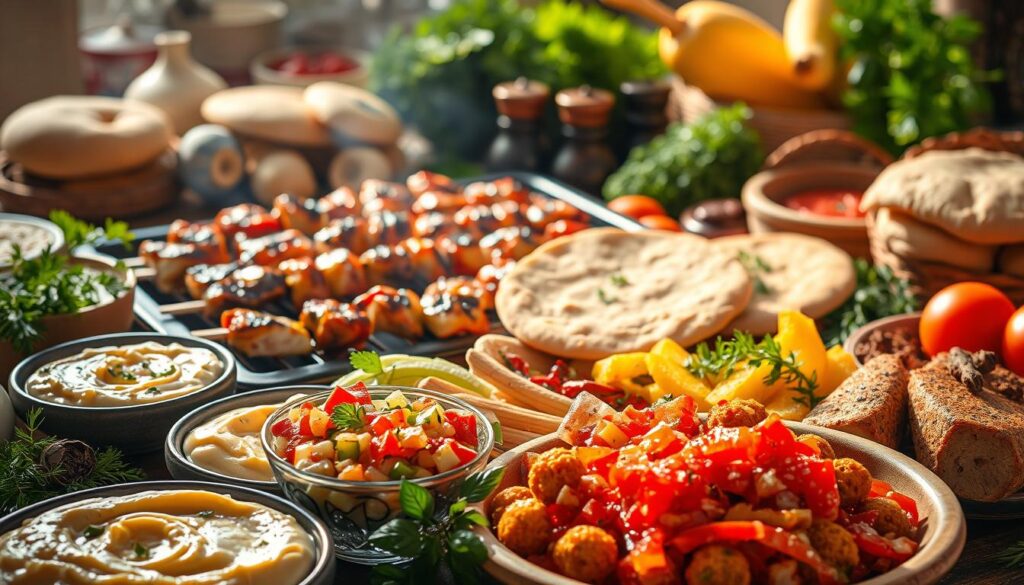Exploring cuisine, you’ll see that Lebanese food shows the country’s rich culture. It mixes Mediterranean and Middle Eastern tastes, offering bold and aromatic dishes. You’ll find everything from juicy meats to fresh veggies, pleasing all kinds of palates.
Lebanese cuisine is more than just food; it’s an experience. The mix of flavors, textures, and smells takes you to Lebanon’s lively streets. Here, the air is filled with spices and fresh bread. Whether it’s your first time or you’re coming back, Lebanese food is a unique journey.
The Flavors of Lebanon
Key Takeaways
- Popular Lebanese food offers a unique blend of Mediterranean and Middle Eastern flavors
- Lebanese dishes cater to different tastes and preferences
- The combination of flavors, textures, and aromas creates a unique culinary experience
- Lebanese cuisine is known for its bold flavors, aromas, and spices
- Popular Lebanese food is a true reflection of the country’s rich cultural heritage
Table of Contents
The Rich Heritage of Lebanese Cuisine
Exploring authentic Lebanese cuisine reveals a world of flavors and traditions. Lebanese dishes show the blend of East and West, thanks to the country’s location. The history of Lebanese food is rich, influenced by many cultures and empires.
Key ingredients like olive oil, garlic, and lemon juice are at the heart of Lebanese cuisine. These Mediterranean diet staples have been used for centuries. They help create a wide range of tasty dishes, from stews and soups to salads and grilled meats.
Historical Influences on Lebanese Food
The Phoenicians, Romans, and Ottomans have all shaped Lebanese cuisine. Each culture brought new ingredients, cooking methods, and dishes. This mix of old and new flavors makes Lebanese food unique.
Key Ingredients in Lebanese Cooking
Olive oil, garlic, and lemon juice are essential in Lebanese cooking. They’re used in many dishes, from simple salads to complex stews. Other important ingredients include sumac, pomegranate molasses, and za’atar, adding flavor and depth.
The Mediterranean Diet Connection
The Mediterranean diet has greatly influenced Lebanese cuisine. It focuses on olive oil, garlic, and lemon juice, along with fresh fruits, vegetables, whole grains, and lean proteins. This diet makes Lebanese food not only tasty but also healthy and nutritious.
Essential Mezze Dishes in Popular Lebanese Food
Exploring lebanese dishes often leads to small plates called mezze. These are key parts of popular lebanese food. They bring a variety of tastes and textures to the table. From creamy dips to crispy fried snacks, mezze is a mix of small dishes enjoyed as appetizers or snacks.
Mezze is perfect for social gatherings, where people share food and chat. The way it’s served is traditional. A variety of small dishes are placed in the center of the table. This lets everyone serve themselves and try a bit of everything.
- Hummus: a creamy dip made from chickpeas, tahini, and lemon juice
- Falafel: crispy fried balls made from chickpeas and spices
- Tabbouleh: a fresh salad made from parsley, tomatoes, and bulgur
These are just a few tasty options in popular lebanese food. Whether you want something creamy or crispy, mezze has it all.
Iconic Lebanese Breads and Pastries
Breads and pastries are a great starting point for easy Lebanese recipes. You can find everything from classic pita bread to sweet knafeh. These items are known for their crusty texture and rich flavors, making them key to Lebanese cuisine.
Popular Lebanese breads include pita bread, ka’ak, and manaqish. These are often served with meals or used as bases for dishes. For instance, pita bread is great for sandwiches or scooping dips like hummus.
Lebanese pastries, like knafah and ma’amoul, are also a treat. They’re perfect for those with a sweet tooth. You can easily find recipes online to try these at home.
To make your own Lebanese breads and pastries, you’ll need basic ingredients like flour, yeast, and olive oil. Many easy recipes are available online to help you. With a bit of practice, you’ll be making delicious Lebanese treats in no time.
Lebanese Main Course Delicacies
Exploring authentic Lebanese cuisine reveals a variety of tasty main dishes. These dishes are known for their rich flavors and aromas. They are often served with rice, vegetables, or bread.
Lebanese main courses offer a unique culinary experience. You can find everything from classic dishes to modern twists.
Lebanese main courses include:
- Meat-based dishes, such as shawarma and kebabs, which are marinated in a mix of spices and herbs
- Vegetarian options, like stuffed grape leaves and eggplant dishes, which are flavorful and nutritious
- Seafood specialties, such as grilled fish and seafood stews, which are fresh and delicious
These dishes are made with fresh ingredients and traditional spices. They are a must-try for anyone wanting to taste Lebanon’s flavors. Whether you prefer something classic or adventurous, Lebanese food has something for everyone.

In Lebanese cuisine, the main course is the meal’s centerpiece. It’s served with various sides and condiments. This mix of flavors and textures offers a unique dining experience.
With its rich history and cultural influences, Lebanese cuisine is a staple in the Middle East. Its main course delicacies are a big reason for its popularity.
Street Food Favorites from Lebanon
Exploring Lebanon’s streets reveals a world of flavors. The country’s rich culinary heritage is on full display. Street food, like crispy falafel and juicy shawarma, offers something for everyone.
Falafel, made from chickpeas, herbs, and spices, is a must-try. Enjoy it in a pita with veggies and tahini sauce. Shawarma, with its thinly sliced meat and warm pita, is another favorite.
Kafta and fatayer are also popular. Kafta is a skewer of ground meat, while fatayer is a savory pastry. These dishes highlight Lebanon’s culinary traditions.
Trying local street food is a must. It offers bold flavors and aromas. Lebanese street food is a treat for any food lover.
Traditional Lebanese Sweets and Desserts
Lebanese cuisine is famous for its wide variety of sweets and desserts. These treats are a big part of Lebanese dishes. They are often served at the end of a meal, offering many choices for different tastes.
Sweets and desserts are key in Lebanese dishes. From the classic baklava to the creamy muhalabia, there’s something for everyone. Some favorites include:
- Baklava: a sweet pastry filled with nuts and honey
- Ma’amoul: a shortbread-like cookie filled with dates or nuts
- Muhalabia: a creamy pudding made with milk and sugar
These traditional Lebanese dishes are not just tasty but also carry a lot of history and culture. They’re often enjoyed at special events like weddings and holidays. They’re a big part of Lebanese tradition.
There are many other Lebanese dishes worth trying. With their unique flavors and aromas, Lebanese sweets and desserts are sure to please any sweet tooth.
Essential Spices and Herbs in Lebanese Cooking
Lebanese cuisine is famous for its bold flavors and aromas. Spices and herbs are key to these tastes. You’ll find a variety of spices and herbs in easy Lebanese recipes. They add depth and complexity to dishes.
Common spices and herbs include black pepper, cumin, coriander, and paprika. These are often mixed with herbs like parsley, mint, and thyme. This mix is used to season meats, vegetables, grains, and legumes. Using these spices and herbs in your recipes will make your dishes delicious and authentic.
Here are some essential spices and herbs to have in your pantry when cooking easy Lebanese recipes:
- Cumin
- Coriander
- Paprika
- Sumac
- Parsley
- Mint
- Thyme
Knowing the spices and herbs used in Lebanese cooking lets you make a variety of easy Lebanese recipes. Whether it’s a simple salad or a complex stew, the right spices and herbs can change everything. So, don’t be afraid to try new combinations and discover new flavors.
Lebanese Beverage Traditions
Exploring authentic Lebanese cuisine reveals the importance of drinks. From bold coffee to soothing tea, Lebanese beverages are known for their unique tastes and smells. We’ll look into Lebanese drink traditions and the many options available.
Drinks are key in Lebanese dining. Whether you’re having a traditional meal or hanging out with friends, Lebanese drinks bring warmth and hospitality. They use top-quality ingredients and traditional methods, showing the country’s rich culture.
Traditional Coffee Culture
Lebanese coffee is a big part of their drink traditions. It’s made with ground coffee, cardamom, and sugar. Served in small cups, it’s enjoyed with loved ones. Drinking this coffee, you’ll taste the bold flavors and smells that have been loved for centuries.
Popular Tea Varieties
Tea is also very popular in Lebanon, with many flavors to try. From herbal teas to sweet black teas, there’s something for everyone. Whether you want to relax or need a refreshing drink, Lebanese tea is perfect.
Refreshing Summer Drinks
In summer, Lebanese drinks are cool and refreshing. Try jallab, a sweet drink with date syrup and molasses, or sharbat, a fruity drink with rose and orange blossom water. These drinks are great for staying cool and hydrated.

Lebanese beverages are a big part of their cuisine. Whether it’s coffee, tea, or a summer drink, you’ll feel the warmth and hospitality of Lebanese culture with every sip.
Modern Interpretations of Lebanese Dishes
Exploring Lebanese cuisine reveals a trend. Modern takes on lebanese food dishes are becoming popular. These new dishes mix old flavors with fresh ingredients and cooking methods. You’ll find everything from fusion cuisine to fresh spins on classics.
Some modern lebanese food dishes you might enjoy include:
- Falafel burgers, a mix of traditional falafel and modern burgers
- Shawarma tacos, combining Mexican and Lebanese tastes
- Vegetarian kibbeh, a new version of the classic meat dish
These dishes are not just tasty. They also show how versatile Lebanese cuisine can be. Modern Lebanese restaurants and chefs are pushing the culinary scene forward. They’re introducing new flavors to the traditional lebanese food dishes.
In summary, modern lebanese food dishes offer a new view on traditional cuisine. They make it appealing to more people. Whether you love food or just want to try something new, these dishes are worth checking out.
| Dish | Traditional Ingredients | Modern Twist |
|---|---|---|
| Falafel | Chickpeas, herbs, spices | Falafel burger with tahini sauce and pickles |
| Shawarma | Meat, tahini, vegetables | Shawarma tacos with salsa and sour cream |
| Kibbeh | Ground meat, bulgur, spices | Vegetarian kibbeh with quinoa and roasted vegetables |
Health Benefits of Lebanese Cuisine
Lebanese food is not just tasty; it’s also full of nutrients. It focuses on fresh ingredients, whole grains, and healthy fats. This makes it great for a healthy diet. You’ll find lots of fiber in fruits and veggies, and protein in meats and legumes.
Some of the key health benefits of Lebanese cuisine include:
- High fiber content from fruits, vegetables, and whole grains
- Rich in healthy fats from olive oil, nuts, and seeds
- Good source of protein from meats, legumes, and dairy products
- Low in saturated fats and added sugars
Exploring Lebanese food, you’ll see many dishes follow the Mediterranean diet. This diet is known for its health benefits, like lowering heart disease and type 2 diabetes risks. Lebanese cuisine is all about whole, unprocessed foods, making it a smart choice for a healthier lifestyle.

Adding Lebanese food to your diet brings rich flavors and health perks. Whether you’re trying new recipes or learning about Lebanese dishes’ nutritional value, there’s something for everyone.
Conclusion: Embracing the Flavors of Lebanon
Discovering Lebanese dishes and authentic Lebanese cuisine is a unique culinary journey. It’s filled with rich heritage, historical influences, and signature ingredients. This vibrant tradition offers a world of flavors that celebrate Lebanon’s culture and identity.
Every bite of mezze spreads, main courses, or desserts takes you to the heart of Lebanese hospitality. The mix of spices, fresh produce, and plant-based options make this cuisine healthy. It’s inspired by the Mediterranean.
Let the flavors of Lebanon guide you as you explore new recipes and authentic restaurants. Immersing yourself in this culinary heritage nourishes your body and broadens your cultural understanding. Embrace the flavors of Lebanon and start a flavorful adventure that will impress your taste buds.
FAQ
What are some of the most popular Lebanese dishes?
Popular Lebanese dishes include hummus, falafel, and shawarma. Also, tabbouleh, kibbeh, and baklava are favorites. These dishes highlight the unique flavors and ingredients of Lebanese cuisine.
What are the key ingredients in Lebanese cooking?
Lebanese cooking uses fresh ingredients like olive oil, garlic, and lemon juice. Herbs and spices are also key. Ingredients include parsley, mint, bulgur, chickpeas, eggplant, and meats like lamb or chicken.
How does the Mediterranean diet influence Lebanese cuisine?
The Mediterranean diet’s focus on olive oil, fresh produce, and whole grains shapes Lebanese cuisine. This diet’s healthy and flavorful approach is seen in many Lebanese dishes.
What are some popular Lebanese mezze dishes?
Mezze favorites include hummus, baba ghanoush, and tabbouleh. Fattoush, kibbeh, and stuffed grape leaves are also popular. These dishes are great as appetizers or shared plates.
What are some iconic Lebanese breads and pastries?
Iconic Lebanese items include pita bread and manakish (za’atar flatbread). Fatayer (spinach or cheese pies) and knafeh (sweet cheese pastry) are also beloved.
What are some traditional Lebanese main course dishes?
Traditional main courses include shawarma and kebabs. Stuffed vegetables and fish dishes are also common. These dishes showcase the heart of Lebanese cuisine.
What are some popular Lebanese street food favorites?
Street food favorites are falafel, shawarma, manakish, and sfiha (meat pies). These dishes are loved for their convenience and delicious flavors.
What are some traditional Lebanese sweets and desserts?
Traditional sweets include baklava, knafeh, and mamoul (shortbread cookies). Muhallebi (creamy milk pudding) is also a favorite. These treats are cherished for their rich flavors and textures.
What are some of the key spices and herbs used in Lebanese cooking?
Lebanese cooking often uses cumin, cinnamon, and sumac. Parsley, mint, and za’atar (thyme, sumac, and sesame seeds) are also common. These spices and herbs add depth and aroma to dishes.
How has Lebanese cuisine evolved over time?
Lebanese cuisine has grown, with modern twists and fusion dishes. While classic dishes are still loved, chefs are exploring new ingredients and techniques. This evolution keeps Lebanese cuisine vibrant and exciting.
There are no reviews yet. Be the first one to write one.

